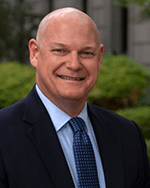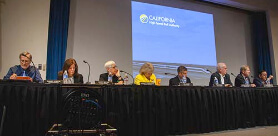CEO Report – September 2020
 Outreach Efforts to Engage Communities in Environmental Clearance Process
Outreach Efforts to Engage Communities in Environmental Clearance Process
At our last board meeting, Vice Chair Miller and Board Member Escutia asked for an update on environmental outreach efforts to English as a Second Language communities and other engagement that our regional staff has undertaken as part of the environmental review process including how the teams have addressed impacts from COVID. I have provided all Board members with two comprehensive documents on these efforts in our Northern and Southern California regions, and today I want to provide a brief snapshot of these efforts.
In Northern California and Southern California, between February and September, our outreach teams conducted more than 100 meetings and presentations. These meetings and presentations include:
- Legislative briefings
- Community working groups
- Stakeholder presentations
- Public meetings and open houses
Before the release of the Draft EIR/EIS’s in both Northern and Southern California, outreach focused on making sure that the public was aware that the documents were about to be released so they could be prepared to review them and submit comments. During the comment period, the focus shifted to answering questions and helping community members and stakeholders navigate the documents. All of this was done in virtual or telephone formats and resulted in attendance equal to that experienced during open houses held in person last year and during the first few months of 2020. More than 22,000 website visits (split between both regions) occurred on new standalone interactive websites created for each project section. These resources, as well as the open houses, office hours, and other engagement, were available both in English and in other languages.
Per the Authority’s EIR/EIS Publication and Public Outreach Guidance and Limited Proficiency Plan – all relevant material was translated into languages that met a threshold of 5 percent or more of the reference community. For the two documents in Northern California, that included translation into:
- Spanish
- Chinese
- Vietnamese
- As well as Tagalog for the San Francisco to San José section
In Southern California for the Burbank to Los Angeles document, that included translation into:
- Armenian
- Tagalog
- Arabic
- Spanish
- Japanese
- Korean
- Vietnamese
- Chinese
In addition, the Authority placed paid social media ads in geotargeted areas in appropriate languages and targeted community outreach was conducted by our regional outreach teams as well.
Updated Environmental Schedule for Remaining Segments of Phase 1 System
As we have recently reported to the Board, we have pushed back our environmental schedules for the remaining Phase 1 project sections, in part due to COVID-19. In some project sections, where we have released Draft EIR/EIS’s for public comment, we have extended the public comment period.
Over the last year or so, we’ve taken an aggressive set of actions to moving the environmental reviews forward. Between 2014 and 2019, the Authority did not certify any Records of Decision (ROD). In October 2019, we certified the ROD for the Fresno to Bakersfield Locally Generated Alternative. Today, the Board voted unanimously to approve the ROD for the Central Valley Wye, which is a supplemental EIR/EIS for the Fresno to Bakersfield project section.
The attached table shows where the Authority is on the adoption dates for the Records of Decision for the remaining Phase 1 system project sections. The middle column indicates our previous estimates for the ROD dates. The new, revised ROD dates are shown in the column on the far right. This reflects some of the actions we’ve taken to extend public comment periods, which pushes back ROD adoption. Also, involved with our environmental review process is a federal agency, the Surface Transportation Board (STB). As the STB is currently staffed, they review our environmental documents one at a time. We have to slot our documents into the period that the STB can take them up. The next document we will submit to them for review is for the Bakersfield to Palmdale project section, our first reach into Los Angeles County, which is proposed to be done April 2021. And you can see the other dates in far right. These are all planned to be done well before December 2022 deadline.
Re-procurement Process for Next RDP Contract (current one expires in 2022)
This section of the CEO report is in response to questions from the Board about how we move forward with the next procurement for an RDP contract.
I just want to lay the process out for that. We would, going forward, do a full competitive procurement process for the next RDP contract. The first important part of that process is engaging in conversations with the Board about what that contract scope, budget and schedule would look like.
Typically, we do a qualifications-based procurement. We release the draft RFQ. We conduct industry forums and small business matchmaking events with the prime bidders on this. Offerors submit their Statement of Qualifications. We evaluate, discuss and negotiate the top-ranked offeror. Then, we move to award and execution. This is the process that was followed last time, and we would do something like this going forward.
There are always variations that we will want to discuss with Board to get the Board’s input on how we want to proceed. We do have some time for those discussions.
The current RDP contract expires in 2022, and so our timeline to move forward with the next contract shows that most of our activity to move forward on this is in 2021. The Board must first approve an RFQ, which we can then put forward in late 2021. The Statement of Qualifications would be due sometime later that year. We then turn to contract negotiations in February 2022. We come back to the Board in March 2022 for approval of contract award, and we would then issue a Notice to Proceed later in March 2022.
There are a couple of issues that we would have to discuss with the Board before moving forward. How expansive do we want the contract to be? Or not to be? There may be lessons learned from the last contract that should be applied. It’s important for us, as an organization, to discuss these types of things early before we get too far into the RFP process.
Program Update
I typically do a program update to inform the Board on things that we’ve done between hearings.
Just yesterday, I’m happy to announce that we put out a release on the formation and opening of our Selma workforce partnership program with the City of Selma. Board Member Perea was very involved on getting this established. This is modeled on the Mandela Center in Oakland, which was a program something that was put together after the Loma Prieta earthquake to help employ local folks on infrastructure projects.
Similarly, here, we’re partnering with the local EDC and labor apprenticeship programs to begin work for students here through the Selma Workforce Training Center. This is also part of our targeted worker program, under which we set goals in each of our construction contracts for workers to work on sites who reside in the area where the program is underway. We are proud to help the City of Selma as it ramps up recruitment efforts for the first cohort of the Central Valley Training Center Program by launching its new website. The website will allow students to easily review the training program’s qualifications and sign up for classes scheduled to start on Oct. 5. This is an exciting new development, and one that we’re working on closely with local entities.
https://hsr.ca.gov/communication/news_room/news_releases/?id=58
We also announced this week the opening of the Avenue 10 grade separation in Madera County. It’s the second grade separation to open the last month, and the first was at Avenue 15, also in Madera county. I can’t think of better safety projects and local traffic circulation projects than grade separations.
The Avenue 10 grade separation is the second one to open in the last month: https://hsr.ca.gov/communication/news_room/news_releases/?id=59
Two weeks ago we opened Avenue 15 grade separation: https://hsr.ca.gov/communication/news_room/news_releases/?id=56
Finally, we put out a press release on Labor Day to acknowledge the workers who are contributing to our project. We are now approaching 1,100 daily workers per week on the construction projects. That is roughly a 270 percent increase over this time last year, and we are very proud of that. Since the commencement of construction, we’ve put out about 4,300 construction jobs in the Central Valley. I just wanted to cover those issues as well. Those are things that have occurred since the last two hearings.
I am very pleased that we’re able to continue the expansion of the job sites and the work, especially in the midst of the COVID-19 pandemic.
https://hsr.ca.gov/communication/news_room/news_releases/?id=57
To see the slides that accompany this presentation, follow this link: https://hsr.ca.gov/docs/about/ceo_reports/CEO_Report_September_2020.pdf
CEO Report Archives
- CEO Report – March 2021
- CEO Report – January 2021
- CEO Report – December 2020
- CEO Report – October 2020
- CEO Report – September 2020
- CEO Report – August 2020
- CEO Report – April 2020
- CEO Report – February 2020
- CEO Report – December 2019
- CEO Report – November 2019
- CEO Report – October 2019
- CEO Report – September 2019
- CEO Report – August 2019
The California High-Speed Rail Authority makes every effort to ensure the website and its contents meet mandated ADA requirements as per the California State mandated Web Content Accessibility Guidelines 2.0 Level AA standard. If you are looking for a particular document not located on the California High-Speed Rail Authority website, you may make a request for the document under the Public Records Act through the Public Records Act page. If you have any questions about the website or its contents, please contact the Authority at info@hsr.ca.gov.


